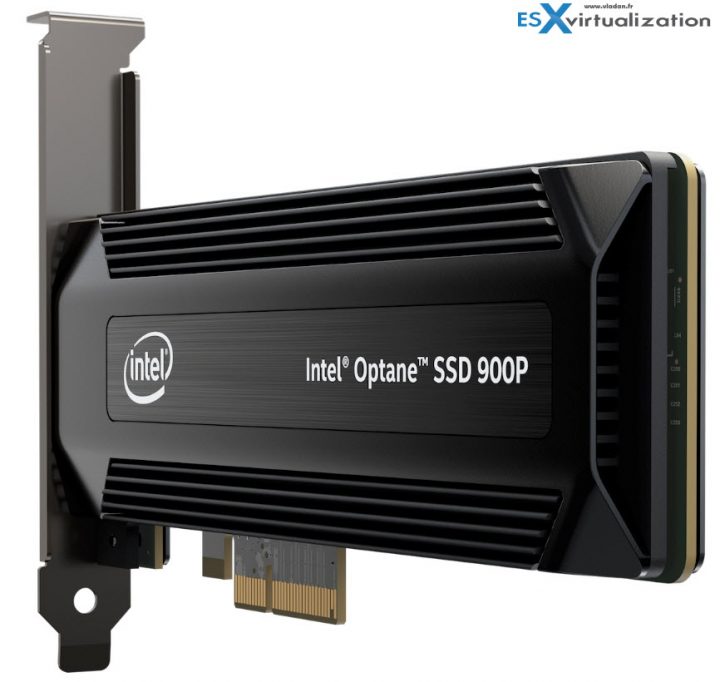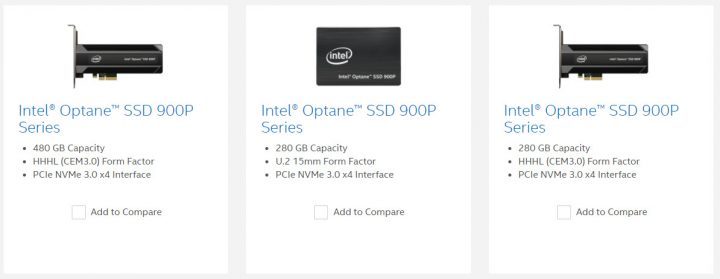This news came from a fellow blogger Erik Bussink with who I had a conversation on Twitter last week. Erik has a MEGA homelab and he put me in a right direction when it comes to a choice of NVMe SSD for a VSAN cache tier. We'll talk about Intel Optane 900p which might be a game changer for homela users but also for the whole IT industry.
At first, I was thinking getting perhaps the Intel 750 or DC P3500 to replace my vSAN cache tier (currently with Intel SATA drives, which is kinda slow) in the lab, but this model is already two three years old. It's a good price/performance value model, still, but I was wondering whether there might be a better choice on the horizon.
In fact, the latest news from Intel (which I missed apparently) is really exciting. Intel is releasing the second generation Optane SSDs – Intel Optane 900p. If you remember, a few months back VMware announced a support for latest Optane drives from Intel with 3D XPoint memory, and the solution was the fastest one tested, on vSAN. This has had of course a price (I saw a $1,791.00 on Amazon), which is quite pricey for a 375GB PCIe NVMe card. Not something a homelabber can afford, right?
Now, the good news is that the Intel Optane 900p will be much cheaper. There will be several capacities available (280GB, 480Gb). Intel is listing 3 different models on their website:
- PCIe NVMe 3.0 x4 Interface 280GB capacity
- PCIe NVMe 3.0 x4 Interface 480GB capacity
- U.2 15mm form factor 280 GB capacity
Image from Intel PR….
Intel Optane 900P – Price?
I've seen the 480GB model (currently not in stock because sold out) on Newegg listed for $599 only. Some sources are announcing $699 (about £530, AU$910) for the 480GB version.
Either of those looks pretty decent considering you might keep the hardware 5+ years as it has 10 Drives Write Per Day (DWPD)…
If that's the offering, then it will make big waves within the whole industry as at this pricing point and this speed, Intel clearly defines a new level of performance, price, and reliability.
The lower priced 280Gb model is announced for $389 (about £300, AU$510).
Intel Optane 900P – Performance?
You can check AnandTech as they published a review of the lower capacity (280Gb) card, which is less performant, but the Intel specs are the fastest on what's current NVMe SSDs can deliver:
- Random Read – 550000 IOPS
- Ramdon Write – 500000 IOPS
- Latency (R and W) – 10 microseconds
Reliability is also assured as the product is guaranteed 5 years with 1.600.000 hours of Meantime Between Failures (MTBF) with 10 WDPD.
Screenshot from Intel…
Even if Intel targets Enthusiasts market, worth to note, that the drive offers a power failure protection which is definitely a must-have for data center systems.
Intel Optane 900P – When should this drive be available?
Intel says it's available on the 26th. Yes, we have passed that date so there might be some shops showing that anytime soon.
From Intel press release:
The Intel® Optane™ SSD 900P Series delivers incredibly low latency and best-in-class random read and write performance at low queue depths – up to four times faster than competitive NAND-based SSDs – opening incredible new possibilities. With the new SSDs, users will unlock more potential from their platform. The Intel® Optane™ SSD 900P Series is ideal for the most demanding storage workloads, including 3D rendering, complex simulations, fast game load times and more. Up to 22 times more endurance than other drives also gives the heaviest users peace of mind.
Intel Optane 900P – Bonus when purchasing
This is something for gamers. At the Intel website you can find this:
Fly at quantum speeds. Purchase an Intel® Optane™ SSD 900P and claim the blazing fast, exclusive in-game Sabre Raven ship and free Star Citizen game while supplies last. Step in, begin the journey, and inhabit a world more immersive than ever before.
Basically, when you buy the drive, you'll get also a free copy of Star Citizen game.
Again from the Intel's site:
To redeem your package, you will need a Star Citizen account, you can set up a new account here. Then enter the code you obtained from Intel below to unlock the Sabre Raven package for free. Once claimed, the Sabre Raven will be added to your inventory and will become flyable with the release of Star Citizen’s Alpha V3.0. You will be given immediate access to Star Citizen 2.6.3 with a the Aegis-Sabre as a loaner ship.
I'm not really into gaming but if you are, you can find the details at this website here.
I have always had some kind of home lab to learn new technologies, new software or be able to work on ESX Virtualization articles. I remember it started first with a single box and then another one for shared storage, FreeNAS. Then another white box, and so on. I had the first iteration of VMware vSAN running on “home-brewed” nodes since its first release. The virtualization learning process worked well for me in the past.
I got much better (and more expensive) lab a few years later. And this lab, which has 3 ESXi hosts and one Whitebox WS2016 with Hyper-V role activate acting as a Backup server, works pretty well so far. But some limits are hit when running more VMs at the same time on the VSAN cluster as the SATA caching tier gets fast saturated (the cache size has only 128 GB too). Adding more capacity there would certainly help, but this does not change the fact that SATA is not a good option for caching tier.
Now I'm seeking something faster and more durable. The 10 DWPD (drive write per day) announced for those Intel Optane 900P cards places this hardware more than for “Enthusiasts” or “Gaming” market as Intel announces, but makes it quite perfect fit for VSAN caching tier.
Lastly, one must not forget about the ESXi hardware support, drivers…. so we'll see how it goes.
Update: You might be interested in exact SKUs when seeking for the products. (Source: El Reg):
Four SKUs are listed in many web shops, all with the name 900P, but the following product numbers and qualities:
- SSDPE21D280GASM, a 2.5-inch drive with 280GB capacity and U.2 or M.2 connections
- SSDPE21D280GASX, as above, but with PCIE 4.0 connector
- SSDPED1D280GASX, a 280GB add-in card for PCIE 4.0
- SSDPED1D480GASX, a 480GB add-in card, again for PCIE 4.0
Wrap Up:
For me, the goal was to get faster-caching tier as currently the SATA drives are limited in IOPS. I think that Intel Optane with a combination of 3D XPoint memory, Intel Memory and Storage Controllers is an awesome piece of technology.
Time will see whether this hardware will make it to the lab or not, as a caching tier. A low latency at low queue depth, with NVMe protocol, is a great feature set to have.
More from ESX Virtualization:
- Ditch Your HDDs For ACloudA Gateway
- VMware API Explorer Is a Free Built-in Utility in VCSA
- What is VMware VMFS Locking Mechanism?
- What is VMware Instant Clone Technology?
- VMware vCenter Server Standard vs Foundation – Differences
- Free Tools
Stay tuned through RSS, and social media channels (Twitter, FB, YouTube)



Can you use the 280GB model that has a U2 connector with a “U2 to M2” converter so you can use this drive with an M2 connector on the motherboard?
Hi,
That’s a good question. I’m not going to tell you that it is possible, but perhaps one of our readers who did? I only have PCIe slots on my mobo so.
Update: Check out the latest update from Intel about adapters and cables.
Technically yes.
U2 and M2 is just a form factor the trick is of capability of the connection. Not every M2 socket supports nvme (PCIe). M2 was designed to replace old SATA and mSATA so check motherboard capabilities.
If You are sure that you have M2 nvme capability slot you can try SFF-8643 to M.2 adapter
if you have no use of the game codes, please trade with me cheers
SSDPE21D280GASM includes the u.2 m.2 cable by the way (requires nvme support)